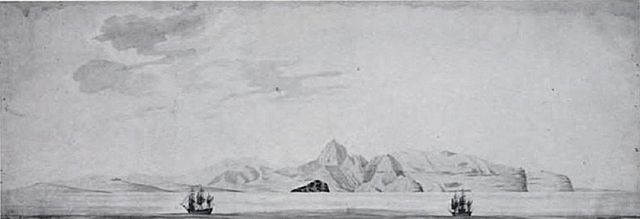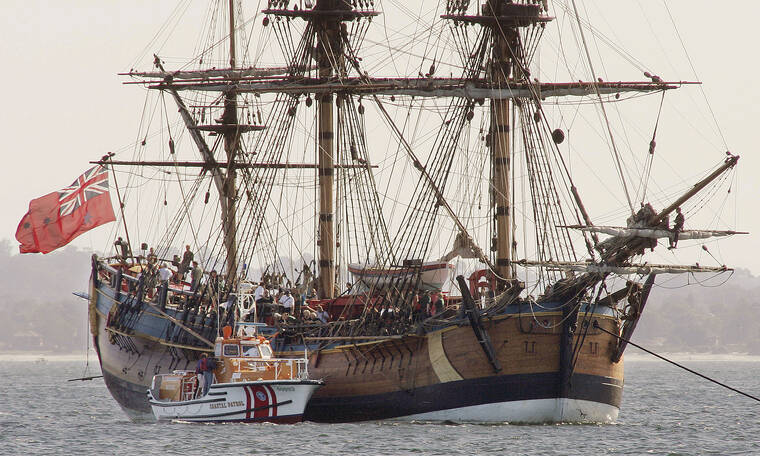John Ledyard, the son of a ship captain, was born in Groton Connecticut in 1751. He grew up in thriving New London County, where the West Indian trade made fortunes for enterprising merchants and captains.
When he was 11, his father and an uncle died at sea. He went to live with his grandfather, then his uncle (he apprenticed in his uncle’s law office.) During his teens Ledyard vacillated between a career in law and one in the ministry. (Bashford)
He took neither and headed to sea.
In March 1775, he boarded a ship to England where he enlisted in the British Army. Four months later, in July, he transferred into the British Navy, joining the Royal Marines. (Drury)
A year later, July 12, 1776, a Corporal in the British Marines, he became part of the last expedition under Captain James Cook (the only American on board.)
It consisted of two ships, the Resolution and Discovery, the former commanded by Captain Cook (with Ledyard aboard,) and the latter by Captain Clerke. (Sparks)
From Britain, the Resolution and Discovery sailed south and east, around the Cape of Good Hope, across the southern Indian Ocean to Tasmania, New Zealand, and from there to the various Polynesian island chains of the South Pacific.
It was in Tahiti that Ledyard is reportedly the first Westerner to be tattooed – with “Otaheite marks on my hands”. (Ledyard)
The expedition continued north and eastward reaching the Pacific Northwest coast of North America. It then sailed north, probing the Alaskan coastline in search of a Northwest Passage, connecting the Atlantic and the Pacific. (Drury)
With cold weather setting in, Cook decided to head to the Sandwich Islands for winter quarters.
“We had been approached several times by some canoes at a distance, but none of them would come near enough to converse with us or that we might see what sort of people they were until we anchored and furled our sails.”
“Those who came first were armed and appeared inexpressibly surprised, though not intimidated. They shook their spears at us, rolled their eyes about and made wild uncouth gesticulations.”
“The next day we were visited by a great multitude of canoes, bringing yams, sweet potatoes, hogs, plantains and other tropical fruits, which they … exchanged for little bits of old iron, nails and other articles.” (Ledyard)
While there, Ledyard requested permission to scale Mauna Loa, for the double purpose of exploring the interior, and, if possible, climbing to the top of the mountain. The request was granted.
The botanist and a gunner of the Resolution accompanied him; Hawaiians were also engaged to serve as guides. (Sparks)
“The woods here are very thick and luxuriant, the largest trees are nearly thirty feet in the girt, and these with the shruberry underneath and the whole intersected with vines renders it very umbrageous.” (Ledyard)
They never made it to the summit, having underestimated its height (13,680 feet,) distance and the thickness of the tropical undergrowth on its slopes, and had to turn back.
He was there when Cook was killed, “Cook and Mr. Phillips were together a few paces in the rear of the guard … Cook having at length reached the margin of the water between the fire of the boats waved with his hat to cease firing and come in, and while he was doing this a chief from behind stabed him with one of our iron daggers … Cook fell with his face in the water and immediately expired.”
“The natives did not attempt to molest the boats in their debarkation of our people, which was much wondered at, and they soon joined the others upon the Morai (heiau) amounting in the whole to about 60.” (Ledyard)
They left the Islands; the expedition returned to England in the fall of 1780. He was obligated to stay there until his enlistment expired early in 1782, while the American Revolution dwindled toward its close.
Refusing to fight against his countrymen, he was detained in barracks for two years. Then, sent out on a frigate that cruised American waters for several months, he jumped ship. (Halliday)
He began to write his ‘Journal of Captain Cook’s Last Voyage,’ published in 1783. After Ledyard’s petition to the General Assembly seeking copyright protection provoked a series of state laws that codified that right. Eventually, a federal copyright law was adopted in 1790. (Drury)
His journeys weren’t over.
Seeking support for a new expedition, he travelled to Europe. He met Ambassador Thomas Jefferson there, and discussed his plans to cross the American continent alone (from Stockholm, Sweden, across Siberia to New England.
Discussion of that journey helped call Jefferson’s attention to the possible value of the Northwest Coast and the need to explore the American continent; it led to the expedition of Lewis and Clark in 1804-1806, after Jefferson became president.
Ledyard would return to the Pacific Northwest on an expedition of his own—not merely to make a fortune in the fur trade, but to realize his dream of crossing the American continent alone (from Stockholm, Sweden, across Siberia to New Engand.)
However, his one-man journey ended a year later when Russian forces loyal to Catherine the Great arrested him in Irkutsk, Siberia, accusing him of being a spy. He was subsequently banished from the country. (Halliday)
A final journey, begun in June 1788, would be Ledyard’s last.
On an expedition to explore the interior of the African continent, he suffered a digestive ailment. His attempt at self-medication, by swallowing sulfuric acid and tartar emetic, eventually claimed his life in January 1789. John Ledyard was 38 years old. (Ray)





























